Menu
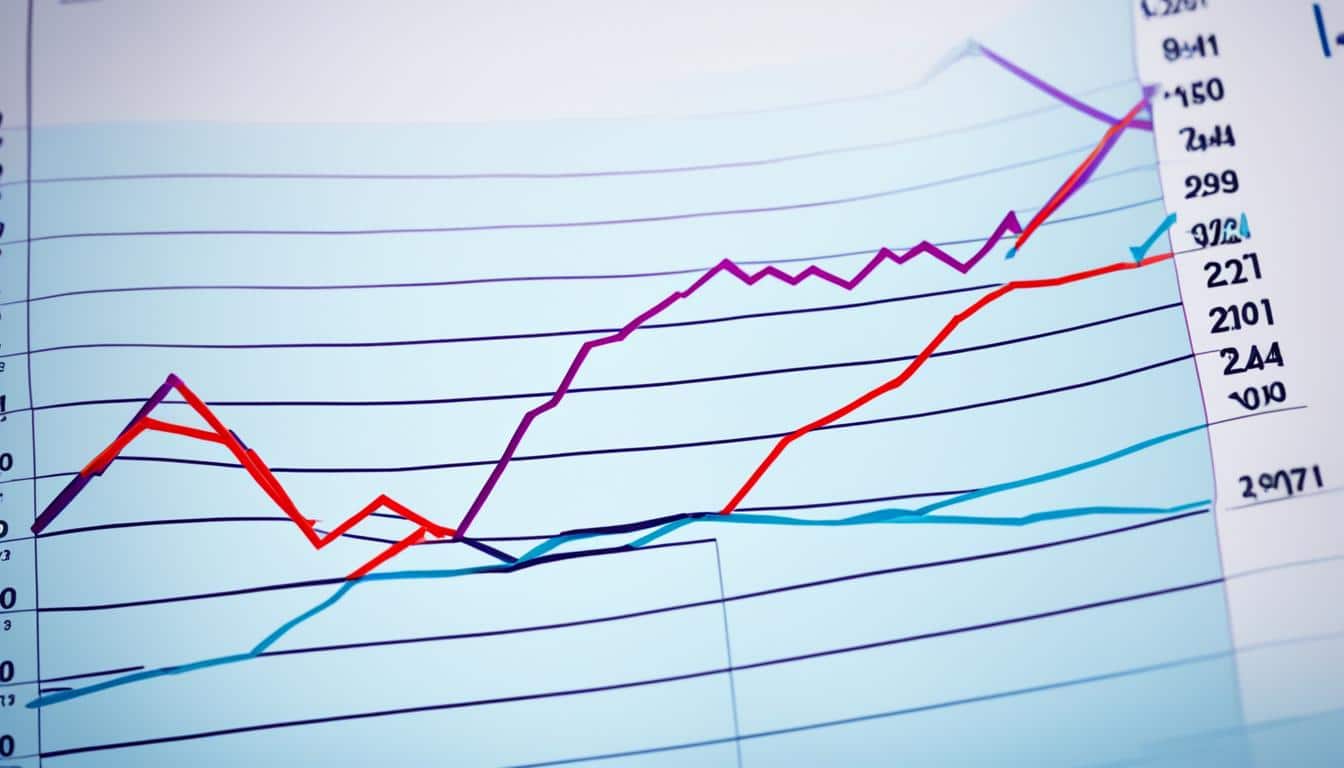
Argus publishes over 40,000 energy and commodity prices every day. This wide range of data is really important. It helps traders make smart decisions in the global markets.
Knowing the latest market info is key today. For those working in finance, getting accurate information quickly is everything. It helps them understand market changes fast.
Our detailed price analysis includes everything from bids to end-of-day prices. There are many ways to get this info. So, you can pick what works best for you and stay on top in the markets.
It’s crucial to know the latest commodity prices and what makes them change. These prices affect companies globally and shape the economy. I want to give you a good price news introduction for smart decisions with global market insights.
Many items, like grains and metals, are traded. They are traded today in various ways, unlike long ago. Gold is special in this trade, used in jewellery and for investing. Weather matters a lot for crops like corn and soybeans.
The start of commodity trade goes way back to old routes, not like stocks and bonds. Today, we see how supply and demand affect price trends. People who speculate or hedge can change prices with their trades.
Energy items like oil and natural gas are very important. Cotton, coffee, and rice can change prices a lot, due to weather and politics. Building things like oil pipelines can be a good investment now.
From what the U.S. Bureau of Labor Statistics says, commodity prices really affect inflation. About 36% of the CPI is made up of commodities, with energy and food being a big part of that. Though prices have mostly gone up a bit, each sector’s changes must be watched closely.
Looking at this price news introduction, we can see how important commodity prices are. They impact inflation and how investors plan. I’m here to give you the global market insights to handle these markets well.
When we look at the current commodity price trends, we see big changes in many markets. For instance, silver prices have hit almost Rs. 90,000 per kg. This is a 5% jump in just one month, making it an all-time high.
The high industrial demand is clear as silver imports have grown by a third for FY24.
Gold prices are also moving up. They have risen by Rs 650 to Rs 74,050 per 10 grams in line with strong global trends. In June, gold futures started at Rs 73,100, showing a steady climb. April saw a big increase in the number of people buying gold, too.
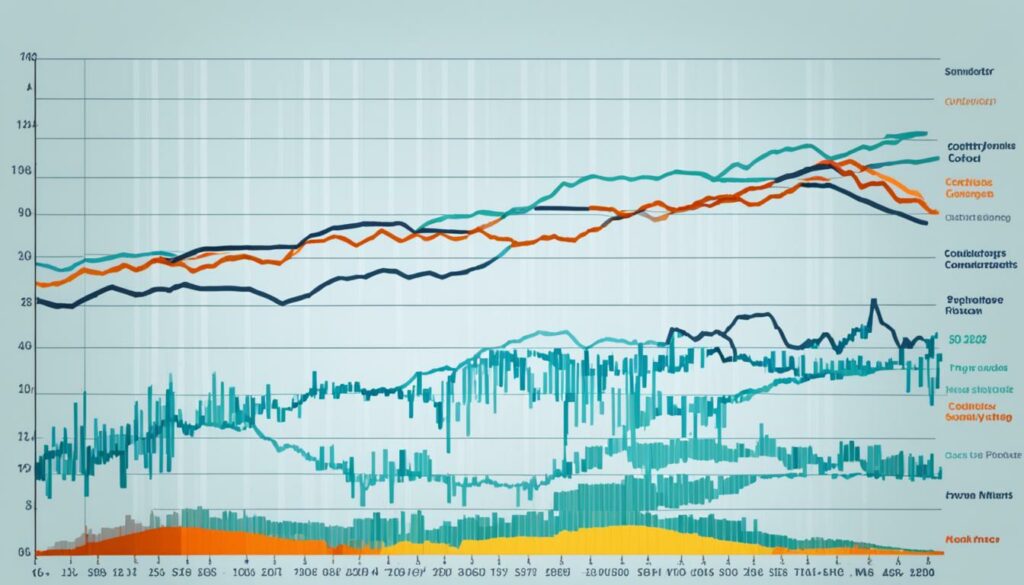
On the flip side, financial markets have seen crude oil prices drop by 1%. They are now at an 11-week low because of lower IEA demand predictions for 2024. This has led to crude oil being close to its lowest price in two months.
However, copper prices have gone up. They have reached over $10,000 for the first time in two years.
The future looks bright for jeera, with prices expected to reach Rs 50,000 in a year. As for mentha oil, it has got more expensive both daily and monthly, by 6% and 25%, respectively. But, a drop in its price might be coming soon.
Looking at wider trade data, the worth of U.S. imports in 2021 for commodity sectors grew by 36.8%. At the same time, U.S. exports in these sectors went up by 35.1%.
| Commodity | Price Movement | Trend |
|---|---|---|
| Silver | ↑ Rs 90,000 per kg (5% increase) | Strong industrial demand |
| Gold | ↑ Rs 74,050 per 10 grams | Aligning with global trends |
| Crude Oil | ↓ 1% (11-week low) | Weaker demand forecast |
| Copper | ↑ $10,000 per metric ton | First time in two years |
| Jeera | Testing Rs 50,000 in 1 year | Expected bullish trend |
These details on the current commodity price trends highlight how market changes affect the financial world, giving experts the info they need to decide wisely.
Recently, commodity prices have been all over the place. This is due to many factors like market conditions and economic signs. It’s vital to know about these changes for smart trading decisions globally.
Several things have led to the changes in commodity prices. For example, silver prices went up by over 5% in a month. This happened because it’s being used more in industries and the US Federal Reserve didn’t cut its rates as people thought. As a result, silver imports increased by a third in FY24. This shows industries are buying more and preparing for higher future prices.
Gold is also becoming more expensive. Its prices went up by Rs 650 to Rs 74,050 for 10 grams. Also, silver hit a new high of Rs 88,000. ANZ analysts think silver prices might rise even more.
How much copper we produce and use does something similar to its prices. Copper prices recently hit a two-year high. They might even go past $10,000. This high demand affects many manufacturing costs, especially in China and Southeast Asia, where prices are going up a lot.
Each commodity faces its unique market forces. For instance, oil prices went down because of falling demand, causing two weeks of losses. Also, political troubles in the Red Sea area dropped basmati rice prices. This was due to export problems.
In agriculture, items like jeera and mentha oil are changing a lot. Mentha oil futures rose by 25% in August because there’s not enough and production might slow. Experts also think jeera prices could hit Rs 50,000 soon.
New economical signs and policies can greatly shift the market too. For example, Mexico raising steel tariffs and the US planning to tax Chinese rare earth magnets by 25% in 2026 show how these changes can affect commodities.
Handling these complex markets requires constant information. Analysts are always watching these trends. They aim to provide the latest data so traders can handle price changes wisely.
Expert market analysis is crucial in the world of commodity trading. It offers insights that help traders make strong decisions. For example, the US is stopping new coal mining in its largest area. This change affects future market trends due to a new energy policy.
On the topic of oil, experts also talk about sanctions. Even with a new candidate in Venezuela, the US plans to keep its current sanctions. This affects trading plans and predictions for the oil market.

In the metals area, Chevron wants to sell its UK North Sea assets. This includes selling its part of the Clair field. These moves are key for future trading strategies, especially in the oil and gas sectors.
| Commodity | Recent Development | Expert Insight |
|---|---|---|
| Steel | US steelmakers and government investing in decarbonisation | Consumers still reluctant to pay the ‘green’ premium |
| Rice | Thai rice prices increased due to high demand from Brazil, Mexico | Market Predictions indicate continued price climbs |
| LNG | Bulgaria awards June LNG tender to Turkey’s Botas | Signals stronger bilateral energy collaboration |
| Steel Imports | Mexico raised steel import tariffs to 25-35% | Impacts on regional market dynamics and trading strategies |
| Rare Earth Magnets | US plans 25% import tariffs on Chinese rare earth magnets by 2026 | Long-term impact on global electronics markets |
Professional insights from more than 600 experts help us understand the market. For instance, copper prices are rising. This is causing trouble for copper fabricators in China and Southeast Asia. It shows how market conditions are tight and affects future plans.
Other insights include the rise in North American softwood lumber exports in the first quarter. And the limited supply of moly oxide is keeping prices moving. This detailed analysis keeps us well-informed in the market.
Learning about changes like the US’s energy moves and oil sanctions is crucial. These insights are invaluable for professionals in the commodity trading market. They help us understand and succeed in the complex world of global trading.
Global commodity prices show us how the economy moves worldwide. Crude oil prices have stayed between $75 and $85 per barrel. They are set to average at $80 per barrel through 2024. This stability is thanks to OPEC+ and their efforts to cut production by 6 million barrels each day.
WCS prices have caught up with WTI. The difference is now only $12-13 per barrel. This change is making more oil available. However, natural gas prices have fallen by about 40%. The cost has gone from $3.80/mmbtu to $2.35/mmbtu. U.S. gas production has held steady. It’s expected that the yearly price in 2024 will be $2.40/mmbtu.
Gold prices are hovering near $2,350 an ounce. They might fall to $2,250 an ounce in 2024. Copper prices, on the other hand, have hit record highs. They are expected to stay high into 2025. Aluminum prices are also up after a year-long standstill due to supply issues.
Zinc prices are almost at their highest in a year. This is because the global economy is doing well. Also, more money is going into metal investments. With over 40,000 price points, Argus covers the global market well.
Notable events recently include a delivery of LSSR oil from Dangote to Europe on May 15, 2024. Economic news points to various things affecting prices. These include a recent collision in Texas and falling crop values hurting U.S. farmers.
The new Dutch government is cutting green hydrogen funds. And, as of May 2024, low-carbon methanol is a pricey choice for bunker fuel. In Europe, there’s worry about not having enough aluminum scrap. This issue is stressing alloy producers. It shows the complexity of the global commodity market.
In May 2024, shipping problems boosted the methanol market. Also, TPC Group’s CEO spoke on April 12, 2024, noting the petrochemical sector’s growth. This underlines the forward movement we see in economic news.
| Commodity | Current Price | 2024 Forecast |
|---|---|---|
| Crude Oil | $75-85/bbl | $80/bbl |
| Natural Gas | $2.35/mmbtu | $2.40/mmbtu |
| Gold | $2,350/oz | $2,250/oz |
| Copper | $4.30/lb | $4.30/lb |
To understand why commodity prices change, we need to look at each region closely. This includes Europe, Asia, and the Americas. We look deeper than just prices to see what really influences these markets. This helps us understand the economy from a global standpoint.
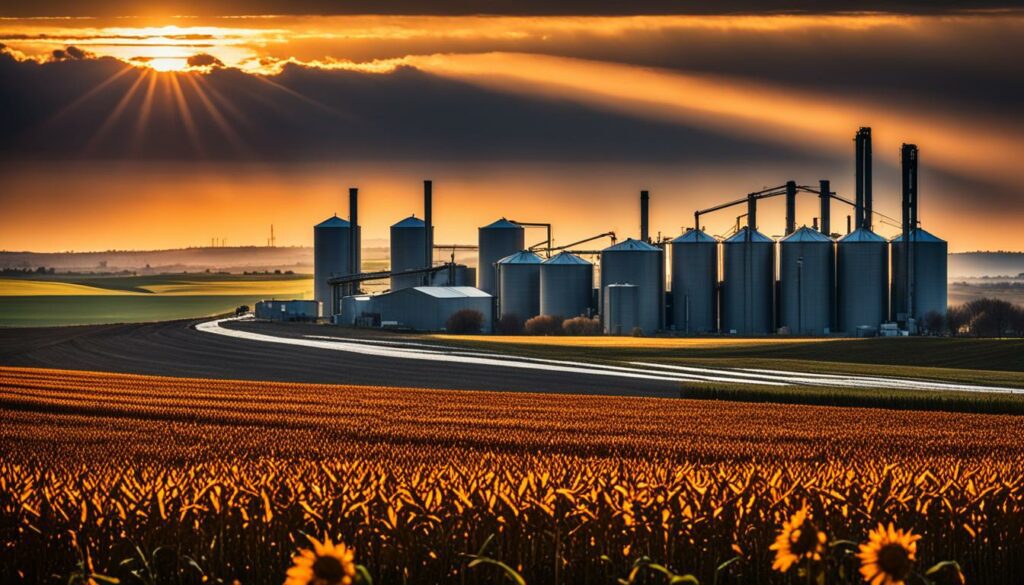
In Europe, the prices of commodities like energy and agriculture change a lot. By March 2024, the price of gold had gone up to nearly $2,200 an ounce from $1,831 in October 2023. This shows how Europe can impact global prices.
Turning to Asia, we see interesting trends in things like metals and fertilisers. Copper, for example, is expected to be 5% more expensive in 2024. This shows Asia’s economy is strong despite worldwide changes. The region’s big need for aluminium and similar metals also affects prices and supply chains everywhere.
The Americas is very active with commodities like crude oil and agricultural products. They expect Brent crude to cost around $84 a barrel in 2024. This suggests the Americas is vital for global oil trade. Plus, the increasing cost of farming, a key part of the consumer price index, highlights its global impact on food prices.
| Region | Key Commodities | Recent Price Trends |
|---|---|---|
| Europe | Gold, Energy, Agriculture | Gold at ~$2,200/oz; Stable energy and agriculture prices |
| Asia | Metals, Fertilizers | Copper +5% projected; Fertilizer prices -22% expected |
| Americas | Crude Oil, Agriculture | Brent crude $84/barrel; Rising agricultural costs |
In summary, different regions play a key role in influencing global market trends. A detailed look at the markets in Europe, Asia, and the Americas shows how these areas help steer commodity prices worldwide.
Studying commodity prices is key to making smart trade choices and predictions. I trust Argus’s methods because they consult with many market players. This makes sure our reports are accurate and up to date.
Argus gives us access to data on 40,000 prices, making our viewpoint unique. This data is trusted worldwide, making deals stable and reliable. Their huge expert team keeps us informed about market changes.
Getting prices right and understanding the economy is crucial. Argus’s assessments are a benchmark for global deals. Using this data helps us predict the market, like how the HVO market in Germany remains strong.
I like that Argus is independent, which shows in their reports. Their unbiased news and analysis help us make good choices in competitive markets.
“With a consistently firm methanol market supported by shipping disruptions, our analysis highlights potential areas of investment for stakeholders,” as noted in an Argus blog post dated 24/04/24.
Prices in the commodity market change quickly, so keeping up is important. For instance, Italian steel centres are seeing losses due to price drops. This shows how vital it is to always analyze the economy and make predictions.
| Market Sector | Current Trend | Future Forecast |
|---|---|---|
| Crops (US) | Sinking values | Continued pressure on farmer profits in 2024 |
| Methanol Market | Firm | Persisting stability into 2024 |
| Steel (Italy) | Declining downstream prices | Short-term losses expected |
| Aluminum (Europe) | Scrap shortages | Potential supply challenges |
Analysing commodity prices is about more than just figures. It’s about understanding what drives those prices. Using this insight with good forecasting helps us work through the complexity of the global market.
Geopolitical events have a big influence on commodity markets. Since 2004, there’s been a big jump in the interest in commodities. This is because of easy money policies and big investments. Conflicts and trade problems can make prices jump in things like oil, gas, gold, and silver. These changes often happen in areas rich in resources.
Experts say it’s key to know about the economy and politics when you look at the markets. They use special methods to understand how one market affects others. Looking at a lot of data helps us see how risk and the markets connect. This can change how stable the markets are.
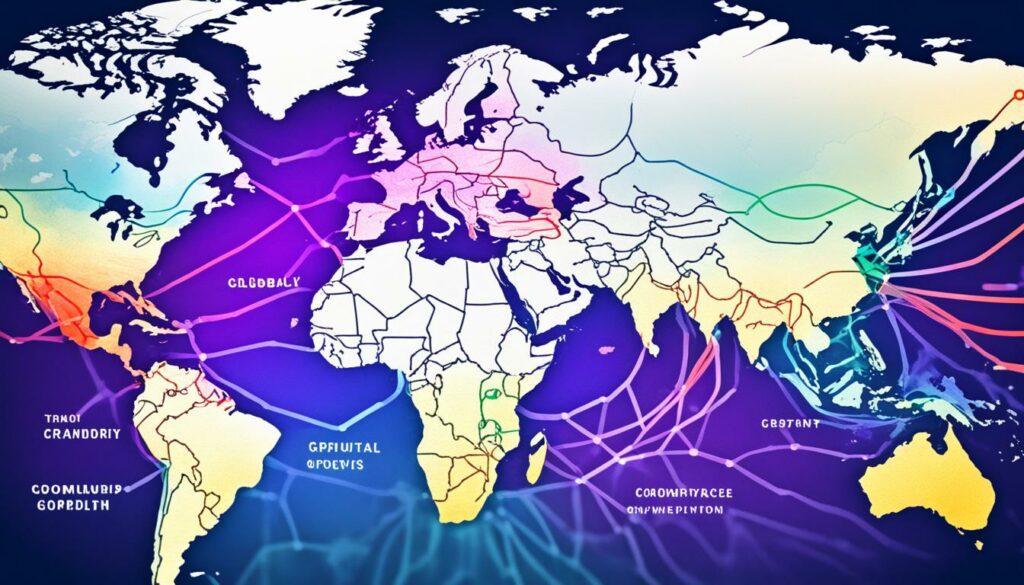
The S&P GSCI looks at energy, metals, food, and more. Studying these using special models can show us how world events hit the markets every week. It gives us a detailed look at these connections.
Events like wars can affect different markets in different ways. We must look at how these changes happen. By checking geopolitical risk monthly and market connections weekly, we can understand how prices and trading are affected.
Looking at global events through special indices can show us how stable the markets are. How commodities react is important for the world economy, especially for countries that sell raw materials. Diversifying what a country sells might protect them from big market shocks.
| Event | Impact on Brent Prices | Duration |
|---|---|---|
| 9/11 Attacks | Increase by 5%, then drop by 25% | Within 14 days |
| Russia’s Invasion of Ukraine | Increase by nearly 30% | First two weeks |
| Israel Terrorist Attacks (7 Oct 2023) | Increase by about 4% | Immediate |
Over the long-term, big world events can shake oil prices a lot at first. But this effect fades fairly quickly. The VAR model shows oil prices might drop about 1.2% after a big global shock. This tells us that while tension can spike prices, it might not last long.
Market risks go up when politics are unstable, as seen in the Middle East. Recent forecasts show troubles there can spike crude oil prices. They might reach over $100 a barrel, affecting the world’s economy.
Ignoring the effects of trade wars and tariffs is a big mistake. They can cause prices to drop suddenly or jump up. For a while, prices fell, but later they levelled off because of ongoing disputes.
The Middle East’s troubles make energy markets very risky. An LNG supply halt could make fertiliser prices shoot up. This would directly affect food prices, showing how crucial it is to be ready for such risks.
| Commodity | 2024 Forecast | 2025 Forecast |
|---|---|---|
| Food Prices | Decrease by 6% | Decrease by 4% |
| Fertiliser Prices | Decrease by 22% | Decrease by 6% |
| Copper Prices | Increase by 5% | Stabilise |
| Aluminium Prices | Increase by 2% | Increase by 4% |
The need to watch trade wars implications is critical. It’s shown clearly by petrol prices hitting over £1.50 per litre in the UK lately.
This week’s weekly commodity market update shows big changes in many sectors. It’s a great read for market experts and traders needing up-to-date information.
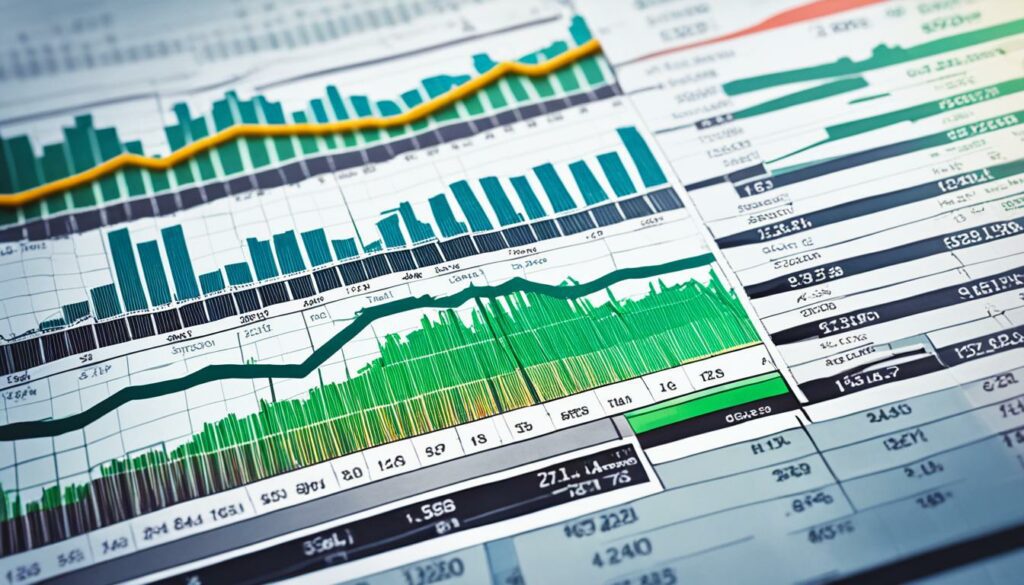
Silver prices rose to nearly Rs. 90,000 per kg this week, hitting a record high. Experts at ANZ think silver could go over $31 by 2024. They say this is because of strong demand and rising gold prices. Speaking of which, gold prices also went up, by Rs 650 to reach Rs 74,050 per 10 grams. This was driven by strong global demand and the Dollar losing value. Many think the US might lower its interest rates, pushing prices even higher.
Moving to base metals, copper prices hit over $10,000 for the first time in two years. But, copper fabricators in China and Southeast Asia are struggling with the high copper costs. This is making it harder for them to do business. In another area, North American softwood lumber exports saw only a small rise in the first part of the year.
Oil prices, on the other hand, dropped by 1%, hitting their lowest in 11 weeks. This happened because the IEA predicted less demand for oil in 2024. On a happier note, commodity prices for things like castor seed, chana, kapas, and jeera went up on the NCDEX. This shows they did well in trading news this week.
Mexico has now raised tariffs on steel imports by 25-35%. This is to help local steelmakers compete better. At the same time, the US is looking to put a 25% tariff on Chinese rare earth magnets by 2026. This will affect the electronics and car industries a lot.
In packaging news, 65% of people in the UK and Germany now like cartonboard packaging. They find it best for their home and personal care products. Also, there was a delay in publishing some lithium prices on May 16. This was a big deal in the battery materials market.
Finally, basmati rice prices went down due to problems in the Red Sea affecting shipments. Yet, mentha oil futures rose 6% in one day and 18% in August so far. This shows there are issues with supply.
Getting real-time market data is key for smart trading choices. Our commodity trading platform gives minute-by-minute updates on bids and offers. It lets me watch market prices straight away. Argus has over 600 global experts who share more than 40,000 energy and commodity prices. They’re a top source of trusted info.
Argus has top-notch tools like Argus Direct®, the Argus Data Science Studio, and Argus Open Markets®. These tools help me quickly get market data. So, I can act fast on my trading plans. Having these tools is a big help in staying ahead in trading, as they offer the freshest details on bids and offers.
Also, Argus has done over 1,300 studies on metal prices for local markets. This helps traders use accurate prices for their deals. The up-to-the-minute data from Argus is a must for anyone in commodity trading. It ensures you make choices based on the latest market prices.
Here’s a quick look at what Argus gives to boost your trading:
| Platform | Key Features |
|---|---|
| Argus Direct® | Real-time access to market data, price assessments, and expert analyses. |
| Argus Data Science Studio | Advanced data modelling and analytics for detailed insights. |
| Argus Open Markets® | Interactive platform providing live updates on bids, offers, and market trends. |
With markets swinging more, fast access to real-time data and detailed prices is vital. These advanced tools make me more confident and precise in commodity trading.
In commodity trading, getting the right data is key to success. Argus stands out by sharing lots of prices. This lets traders make smart choices using real-time info.

Having live data helps traders a lot. They use smart tools, like machine learning, to guess what markets will do next. By mixing real and financial prices, Argus helps traders act fast and smartly.
Traders use many ways to gather data, like asking people online or using special models. This ensures the data is fresh and fits what’s really happening. So, decisions are better, and risks are lower.
| Methods | Benefits |
|---|---|
| Online Surveys | Cost-effective, global reach, minimal investment |
| Machine Learning Forecasting | Accurate predictions, integrates with financial models |
| Real-Time Analysis Tools | Immediate data availability, enhanced decision-making |
Argus’s use of data and forecasts keeps traders ahead. These tech methods help them make quick and right decisions in a changing market.
In 2021, the U.S. saw big jumps in what it bought and sold in many commodity areas. *Sector analysis* found that the U.S. bought more commodities, which rose by 36.8%. Non-commodity goods increased by 16.6% only. On the other hand, what the U.S. sold abroad grew by 35.1% in these areas, showing strong *commodity sector performance*.
Globally, commodity prices increased notably. For example, energy prices went up by 82%. This change was mainly because crude oil prices increased by 64.7%. Agricultural product prices jumped too, including 40.3% for palm oil. These rises were due to the world economy growing by 5.5% in 2021, which led to more people wanting these products.
Looking at the *commodity sector performance*, nearly every type of import increased. Agricultural products saw an 18.6% increase, minerals and metals 28.3%, and energy products a huge 74.1% more. Forest products also climbed 37.0% from 2020 to 2021. Import prices for goods like refined copper went up by 53.1%, showing a general increase in commodity market prices.
| Commodity Sector | Import % Increase (2020-2021) | Export % Increase (2020-2021) | Average Unit Value Increase % |
|---|---|---|---|
| Agricultural Products | 18.6% | 35.1% | 40.3% |
| Minerals & Metals | 28.3% | 32.3% | 53.1% |
| Energy-Related Products | 74.1% | 58.1% | 64.7% |
| Forest Products | 37.0% | NA | NA |
*Price trend monitoring* shows U.S. exports of minerals and metals rose by 32.3%, and energy products by 58.1% in the year. This impacted the Consumer Price Index (CPI) a lot. Energy makes up around 7% and food over 13% of the CPI. They are a big part of what causes inflation rates to go up. Food prices went up by 2.2% in the 12 months to February 2024, and overall inflation was at 3.2%.
The *specific market trends* show commodity prices moving a lot and going up, driven by bigger global economy and more need for certain products. It’s very important to watch these prices closely for smart trading decisions.
The energy sector shapes the global market with its changing prices. The US is leading by decreasing mining in big coal areas. This shift supports using more renewable energy. Yet, many people don’t want to pay extra for it.
The metals and mining world is changing fast. Chevron is selling its North Sea oil and gas places. This move is key in the oil and gas industry. Prices for molybdenum oxide have stopped moving sideways. This is because the supply is getting tighter. Understanding these shifts is vital for investors interested in the mining sector.
The agriculture market shows a mix of high and low prices. Thailand’s rice is in high demand from Brazil and Mexico. This demand has pushed prices up. Also, Bulgaria awarded a tender to Turkey’s Botas for LNG in June. This shows how prices and trends in agriculture and food can quickly change. Investors can learn a lot by keeping an eye on these changes.
Exploring the landscape of emerging markets shows big potential in commodity market growth. This is due to global demand changes and new investment chances. Over recent years, global commodity prices dropped by 40%.
The World Bank predicts a 3% decrease in 2024 and a 4% decrease in 2025. This shows the market’s strength and chances for growth.

After COVID-19, commodity prices are set to be 38% higher than before. The pandemic had a lasting effect on these markets. For example, Brent crude oil prices are now at $91, much higher than before COVID-19. They are expected to drop to $84 in 2024 and $79 in 2025.
Yet, if there are big issues, oil prices might go over $100 per barrel. This could lead to global inflation.
In 2024, gold prices are likely to reach a record high then drop in 2025. Copper and aluminium prices will also rise a bit in 2024 but stay stable in 2025.
This shows there are good investment chances, especially in green technologies and infrastructure.
The value of power and gas trading has more than doubled in recent years. It went from $7 billion to $13 billion between 2018 and 2022. This reflects the overall growth in the commodity sector.
This growth offers good chances for investors in emerging markets, especially because investments in traditional hydrocarbons are shrinking.
In 2021, about $700 billion was put into the energy transition. While this is less than the $2 trillion some say is needed, it’s still a big investment opportunity in clean energy and sustainable technologies.
To navigate these emerging markets well, it’s key to keep track of future trends and market dynamics. Using data and market intelligence is crucial to grab the opportunities and reduce risks.
For example, the value of commodity trading more than doubled from $27 billion in 2018 to an estimated $52 billion in 2021. This shows the great growth potential in these markets.
| Commodity | 2022-2023 Price Change | 2024 Projection | 2025 Projection |
|---|---|---|---|
| Global Commodity Prices | -40% | -3% | -4% |
| Brent Crude Oil | $91 per barrel | $84 per barrel | $79 per barrel |
| Gold | Record High | Moderate | Stable |
| Copper | – | +5% | Stabilise |
| Aluminium | – | +2% | +4% |
Looking at commodity price forecasts gives us insights into the market’s future. The World Bank reports that the commodity price index dropped 24% in 2023. It might fall by another 4% in 2024. These changes are key for planning investments, showing future trends clearly.
2024 could see a 5% drop in energy prices. Agricultural prices might also fall by 2% in 2024 and 2025. On the other hand, metal prices are expected to drop in 2024. But, they could rise by 6% in 2025. This shows how dynamic these forecasts are, needing constant updates to follow market trends.
In the third quarter of 2023, commodity prices went up by 5%. However, they were still 29% lower than their peak in June 2022 by October’s end. This shows why it’s vital for traders and investors to analyse future prices carefully.
For example, oil prices jumped from $72 to over $90 by the third quarter’s end. The average for 2023 might end up at $84 per barrel, less than 2022’s $100. In Europe, natural gas prices might fall by 68% in 2023. They could go down by another 4% in 2024. In the U.S., natural gas prices are expected to drop by 20% in 2024.
| Commodity | Q2 2024 | Q1 2025 |
|---|---|---|
| Crude Oil | 79.136 | 82.134 |
| Natural Gas | 2.5078 | 2.6449 |
| Coal | 143.75 | 150.19 |
| Gold | 2,376.49 | 2,483.74 |
| Copper | 4.8580 | 5.2687 |
| Lumber | 527.55 | 579.95 |
| Soybeans | 1,222.93 | 1,124.89 |
| Palm Oil | 3,832.00 | 4,144.03 |
| Iron Ore | 116.30 | 124.60 |
| Lead | 2,291.50 | 2,435.66 |
| Aluminium | 2,594.50 | 2,763.20 |
| Neodymium | 495,000 | 469,359 |
| CRB Index | 338.10 | 352.61 |
| EU Carbon Permits | 70.79 | 61.67 |
| Wind Energy Index | 17.18 | 16.11 |
“Food insecurity is rising, with over 900 million people affected in 2022. Food prices experienced a 6% decline over the past year, underscoring the significance of accurate investment forecasting for addressing global challenges.”
Right now, checking commodity price forecasts and market trends is super important. Looking ahead helps us see the market’s future movements. This lets us grab investment chances and understand the complicated world of commodities better.
In the latest news, silver prices have gone up a lot, now nearly Rs. 90,000 per kg. This is a big increase of over 5% in just a month. Silver imports also jumped by about one-third in FY24, showing that industries are buying more and prices are steady.
Gold prices are rising too. They increased by Rs 650 to reach Rs 74,050 per 10 grams. This includes a record high in May, when silver reached Rs 87,476 per kg, a Rs 6,600 increase.
ANZ analysts think silver could go over $31 by 2024. This is because gold prices are also rising. The current gold price for June futures is Rs 73,100, with hopes of more cuts in rates.
Gold prices rose by Rs 1,350 in ten days to Rs 72,010 per 10 grams, and silver climbed over Rs 85,000. Oil prices are up too, due to fires in Canada and less stock in the US.
But, not all things are going up. Crude oil prices are nearly the lowest in two months, which might signal a change. Copper prices are at highs, but could soon drop a bit. Jeera might reach Rs 50,000 in a year, but Basmati prices are down due to export issues.
| Commodity | Current Price | Recent Increase |
|---|---|---|
| Silver | Rs 90,000 / kg | 5% in a month |
| Gold | Rs 74,050 / 10 grams | Rs 650 |
| Copper | Multi-year highs | Potential correction |
Cotton prices look like they will stay high for a while, above the MSP. Mentha oil futures went up by 6% in a single day, and 25% in August. This makes some wonder if there will be a price drop soon.
Argus has been offering clear market news for over 50 years. They publish details on over 40,000 market prices globally. This helps people in the market keep up and make smart decisions.
In today’s quick financial world, it’s key to stay tuned with live commodity news. Having the right news sources and market info is crucial. It helps you be ahead. I’m here to show you the best ways and sources for staying updated with live market news.
Key platforms give info that is perfect for serious traders and investors. These sources mix real-time updates, tools for analysis, and interactive options. They make it easier for users to make decisions.
| Platform | Core Features | Audience Engagement |
|---|---|---|
| Live Center | Real-time business news, market insights, breaking news updates | High engagement through interactive features |
| Fantasy Funds Game | Enhances financial literacy, engages tens of thousands within news organisations | Significantly high due to gamified learning |
| DN Investor | Updates about 50k visitors daily with website traffic increment | Increasing website traffic and reader engagement |
| Pulse | Provides intuitive analytical tools, explores and monitors markets in real-time | High due to real-time exploration and monitoring |
| Commercial Partnerships | Strategically places relevant content to increase advertisers’ revenue | High through revenue-enhancing content placement |
| Live Blog Feature | Constant breaking news updates in a consumable manner | Improved reader engagement |
Use these platforms along with a news subscription for a regular market intel. Big names like Bloomberg, Reuters, and CNBC can offer detailed coverage. This keeps you updated all the time.
By using these tools, you can get ahead in commodity trading. Live updates in commodities always need your full attention. Aim for timely details to make profitable moves.
The impact of technology in trading is huge. It has completely changed commodity price analysis. Through tools like machine learning and electronic trading, we have seen huge improvements. This includes making over $100 billion EBIT in 2023 and getting real-time insights through digital sources.
The change is clear. From 2022 to 2023, the price movement for WTI fell by 30%. Meanwhile, Dutch TTF Natural Gas price swings dropped by 58%. This trend was also seen with other commodities, like Henry Hub and copper, thanks to these technological advances.
This wave of innovation means trading has become smoother. In 2023, European energy traders spent over $5 billion on BESS. They also increased their LNG import capabilities. This was by 40 billion cubic meters, with plans to add another 30 billion cubic meters by 2024. It shows how the market is embracing new technology.
Thanks to these tech changes, there’s been a big jump in the value of trading. Power and gas trading went from $7 billion to $13 billion. Oil trading also saw a large increase, with its EBIT reaching $18 billion, up more than 90 percent. These results clearly link the use of technology with better market performance.
In short, technology in trading and tech-driven analysis are crucial in today’s commodity tech trends. They help make smart trading choices and run markets smoothly.
After exploring commodity price news, we can see how vital it is to understand market movements today. Argus is sharing over 40,000 prices worldwide, giving us data that can influence our trading choices. This overview has highlighted the importance of market analysis.
We’ve learned about current commodity states and what might affect their future prices. For instance, the first delivery of low-sulfur fuel oil from Nigeria to Europe is a big deal. Our look at commodities has also discussed how worldwide economic and political issues impact various markets.
Looking forward, it’s clear that having the right market intelligence is key for trading commodities. The decisions of the New Dutch government on green hydrogen and the stable methanol market due to shipping problems in 2024 show how complex the market can be. Even the challenges faced by the HVO industry in Germany underline this complexity.
From Argus’s 50 years of experience in providing market intelligence, we clearly see the value in deep market understanding. With over 1,300 metal prices for each region, and global events by Argus, there’s a treasure trove of information available. I trust this analysis has been insightful and helpful for your trading strategy. It’s crucial to use these tools and insights to keep ahead in the market.
The latest trends in commodity prices are changing. This change is due to things like geopolitical events and how much people want them. Keeping up with these changes can help us understand the market well.
Knowing the latest prices is key for traders. It gives them the information they need to make smart decisions. By following the market, they can reduce the chances of losing money.
Argus uses its platforms like Argus Direct® to give global updates on commodity prices. It also uses the Argus Data Science Studio and Argus Open Markets®. This way, people can see real-time prices and expert commentary.
Prices can change because of many things. This includes world events, changes in supply and demand, and how people feel about the market. Understanding these factors can help predict price movements better.
Experts offer deep insights and forecasts about commodity trading. Their knowledge helps in understanding a complex market. They can also predict future trends.
Events like conflicts or trade disputes can change prices. They do this by affecting the supply and the way people feel about the market. For example, issues in the Middle East can cause the price of oil to go up and down.
Trade wars and tariffs can make things more expensive and disrupt the supply chain. This can change prices. Adding taxes on essential items might also change how countries trade and make markets more unpredictable.
Getting the latest data quickly helps traders make fast decisions. Platforms like Argus Direct® are great for this. They provide all the data needed to trade wisely.
Using live data helps traders make quick and accurate choices. Machine learning can make forecasts better, helping traders avoid risks. This makes decision-making smoother and smarter.
The energy sector is changing a lot. This is because of world tensions, green policies, and new technology. These changes show us where the energy market is heading.
Markets for things like lithium and rare earth elements are growing quickly. More people need these for green technology and storing energy. Recognising these growing markets can lead to great investment chances.
Price predictions use old data, market trends, and expert views. They help a lot but unexpected events can change things. That’s why keeping track and analysing the data is crucial for making wise decisions.
To stay on top of the latest in commodities, trust sources like Argus, Bloomberg, and Reuters. Subscribing to these sites gives you all the news and updates you need.
Technology, especially machine learning, is making price analysis better. It’s leading to faster, more accurate predictions. This helps in creating stronger trading plans.